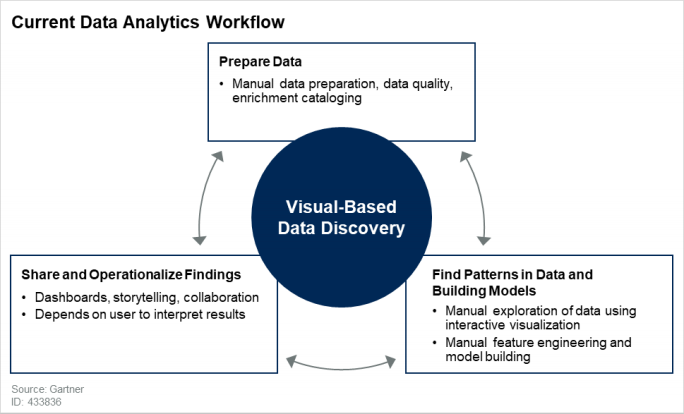Machine Learning and Augmented Analytics to Optimize Business Intelligence
Sanam Malhotra | 27th March 2020

Artificial intelligence (AI) is propelling business intelligence to move beyond dashboards. Machine learning and data science are giving birth to ground-breaking augmented analytics technology. As an evolving provider of machine learning development services, Oodles AI explores and explains the profound implications of augmented analytics on business intelligence. From automated data preparation to visualization, let’s discover how machine learning and augmented analytics are reinforcing business intelligence for expansive development.
Augmented Analytics: Top-notch Business Trend 2020
Augmented analytics or augmented data management is an emerging technology that combines AI and machine learning techniques to extract insights. The technology is poised to automate traditional data preparation, insight generation, and analytics practices across business ecosystems. Backed by artificial intelligence services such as natural language, augmented analytics uses statistical and customer data for profound business intelligence and analytics.
As explained by former IBM Analytics Insider, Jen Underwood,
“Next-generation augmented analytics capabilities can automatically prepare and cleanse data, perform feature engineering, find key insights and hidden patterns.”
Moreso, Gartner projects augmented analytics as “the future of analytics” for business intelligence. Gartner’s Market Guide for Augmented Analytics Tools suggests that
“By 2021, augmented analytics will be a dominant driver of new purchases of analytics and business intelligence (BI) as well as data science and machine learning (DSML) platforms, and of embedded analytics”
Traditional BI Vs Augmented Analytics
The current analytics space in global businesses involves manual interventions to perform activities such as data preparation, insight discovery, and action. Due to its complex nature, data scientists struggle to identify key data patterns and insights in a cost and time-effective manner. On top of it, manual analytics outputs are biased and inaccurate, thus compromising the quality and impact of business strategies.

In comparison to legacy BI practices, augmented analytics ushers a new wave of data science and machine learning capabilities into business models. In addition to automation, augmented analytics involves explainable AI techniques to simplify insight generation for naive and experienced data scientists. The technology democratizes data preparation, exploration, and distribution processes for businesses to formulate effective growth and marketing strategies. Gartner demonstrates the process in detail-

Machine Learning and Augmented Analytics Solutions For Enterprises
1) Augmented Data Preparation
Data preparation is the foremost and most critical step under analytics encompassing the collection, processing, and consolidation of datasets. Until the introduction of artificial intelligence, data preparation was a manual bottleneck laden with human errors and narrow results.
With augmented analytics powered by AI and ML capabilities, businesses can automate key data preparation steps such as-
a) Data matching and profiling
b) Tagging and annotating data
c) Data harmonization, metadata development, modeling, manipulation, and cataloging.
d) Data quality and enrichment recommendations
e) Data lake administration
On average, a data analyst spends 80% of their time cleaning the data. However, augmented analytics can boost the speed and scale of data preparation activities with significant margins.
Also read- Mobilizing Big Data for Cloud-based Predictive Analytics
2) Automated Descriptive Insights
Data preparation is followed by data visualization that encircles the identification, visualization, and narration of key findings. Traditionally, the process fostered hundreds of rows and columns in an excel spreadsheet that demanded human efforts for communication and delivery.
Under the light of augmented analytics, businesses can transform how users explore, understand, and use data via visualizations and conversational interfaces. Some key augmented analytics capabilities under visualization include-
a) Key driver analysis
b) Segment and cluster identification
c) Anomaly detection
d) Predictive analytics
e) Contextualized insights
Natural language processing (NLP) techniques are becoming a powerhouse for conversational AI integration across business platforms. The future of business intelligence will foster text and voice-based search applications combined with augmented analytics for more accessible and useful user analytics.
Also read- Optimizing Conversational Intelligence with AWS Cloud Consulting
Oodles AI Machine Learning and Augmented Analytics Solutions
At Oodles, we are making constant progress toward an AI-infused business ecosystem with our AI and ML development services. We offer emerging and established businesses various machine learning tools and techniques to automate, accelerate, and optimize key processes with efficiency and ease. Our capabilities under augmented analytics include-
a) Automated data preparation models
b) NLP-based conversational interfaces
c) Augmented data cleaning and segmentation
d) Predictive Analytics, and more.
Connect with our AI experts to know more about our AI and ML development services.
Image Source- Gartner



